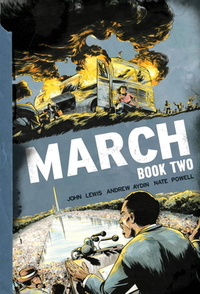Take a photo of a barcode or cover
challenging
informative
inspiring
reflective
medium-paced
A good follow-up to Vol. 2. I especially liked that Mr. Lewis explained and explored how different figures and factions within the larger Civil Rights Movement had differing opinions on what they were focused on, and willing to do to achieve their goals. I also liked that Mr. Lewis depicted the back and forth between various leaders and officials in government.
Too often we teach political history as some type of inevitability, where everyone eventually gets on the same page about how and what and why we're going to do something. But as we saw in the book, organizing brings together all types, with all types of goals and opinions on how to get there, and if we want to learn how to successfully organize in the future then we must learn to acknowledge that know.
Too often we teach political history as some type of inevitability, where everyone eventually gets on the same page about how and what and why we're going to do something. But as we saw in the book, organizing brings together all types, with all types of goals and opinions on how to get there, and if we want to learn how to successfully organize in the future then we must learn to acknowledge that know.
The story of the civil rights movement from John Lewis' perspective continues in this powerful graphic novel. This chapters focuses on the Freedom Rides and the March on Washington. I've studied the civil rights movement before, but it's just so eye-opening to keep engaging with it and realize the insane reality of what was happening.
challenging
informative
reflective
tense
fast-paced
If you only three three more books in your entire life, make it this one, and Books One and Three of this series.
emotional
informative
reflective
medium-paced
March: Book Two starts with the Freedom Riders and ends with the March on Washington in 1963. I enjoy learning more about the Civil Rights movement in the US. John Lewis, Andrew Aydin and Nate Powell have done a beautiful job writing and drawing these graphic novels. I honestly believe March fits in with classic non-fiction graphic novels, such as Maus: A Survivor's Tale and Persepolis.
My education on the civil rights movement, or at least what I picked up from my education, was something along the lines of "Martin Luther King Jr. had a dream and then we had equality." I have since learned that there was a lot more going on, but March (both books one and two) show this on a level that to me is even more visceral than a movie like Selma. The authors do so much with so little. I knew vaguely of the Freedom Riders, but I didn't really understand how dangerous it and other acts of protest were. I also didn't know that the freedom rides took place after segregation on buses and bus stations was outlawed.
The juxtaposition of John Lewis's early civil rights work and President Obama's inauguration could be maudlin, but to me it works perfectly. The inauguration just peeks in every once in a while. I also appreciate seeing the connections between the movement then and Black Lives Matter and other anti-racism and anti-police brutality movements today.
Some of the events and language might be intense for young people, but I hope schools will consider adding these books to their curricula. I imagine reading this story will inspire people to learn more about the movement and think about it more deeply. It certainly has done that for me.
I've read both books one and two now, and each one took me less than an hour. I can't think of a more efficient way to learn about this important part of our history. I will be reading book three as soon as it comes out.
The juxtaposition of John Lewis's early civil rights work and President Obama's inauguration could be maudlin, but to me it works perfectly. The inauguration just peeks in every once in a while. I also appreciate seeing the connections between the movement then and Black Lives Matter and other anti-racism and anti-police brutality movements today.
Some of the events and language might be intense for young people, but I hope schools will consider adding these books to their curricula. I imagine reading this story will inspire people to learn more about the movement and think about it more deeply. It certainly has done that for me.
I've read both books one and two now, and each one took me less than an hour. I can't think of a more efficient way to learn about this important part of our history. I will be reading book three as soon as it comes out.
I know this book deserves 5 stars! It should be on every library and classroom bookshelf. Heck, it should be required reading for every single American! My 3 star rating is simply a personal preference. I don't read a lot of graphic novels, and I struggle reading this format. I'm still glad I read it, though!
Look, I'm not going to add anything witty or insightful or new here. Just: read it.
challenging
informative
tense
fast-paced




